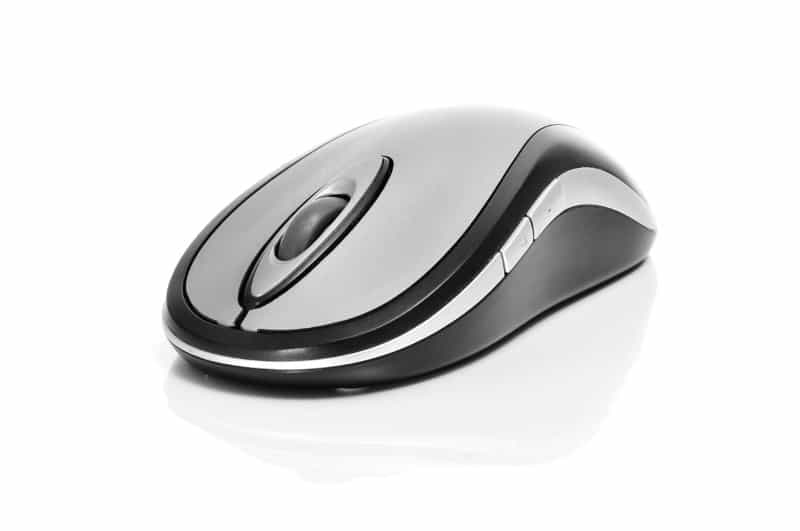With the rapid advancement of technology, more people are embracing the use of wireless devices due to their portability and ease of use. Some of these devices have such good range that you can operate your computer or laptop while seated at your sofa.
One of the most commonly used wireless devices available is the wireless mouse. Continuous use of the wireless mouse raises the question, “does a wireless mouse emit radiation?”
A simple wireless computer mouse emits a small amount of electromagnetic radiation. A wireless mouse emits radio frequency waves which are also a source of EMF radiation.
A wireless mouse with a USB receiver emits more electromagnetic radiation while transmitting signals. PS2 mice have low emissions of electromagnetic waves compared to the wireless mouse.
Wireless mice transmit signals at a rate of 2.45 GHz and radiate at 2.4 GHz. As you place your hand over the mouse circuit, you can get exposed to the radiation. The fingers are placed next to the internal circuit board, and as you turn the wheel, you get more exposure through the hole of the plastic cover where the wheel comes out.
The device emits electromagnetic radiation as it issues commands to the computer through the air. The radiation emitted is harmful to the human body.
Too much exposure from the mouse can result in pain in several points in your fingers, bones and even muscles. Prolonged exposure to the radiation may cause serious damages, such as altering the DNA cells in the body.
Different types of radiation connect to different wireless devices and each transmit at a different frequency and wavelength. The frequency of most wireless devices is typically between 3 KHz to 300 GHz.
The majority of wireless mice and keyboards use Bluetooth technology to send signals to the computer, and they emit a lot of EMF radiations.
How Radiation from a Wireless Mouse Affects You
Those who have electromagnetic hypersensitivity (EHS) report having tingling sensations and numbness of the fingers when using the computer. This problem is mostly caused by using a wireless mouse and/or wireless keyboard.
Though a wireless mouse and keyboard may be very convenient for you, they expose you to microwave radiations similar to those emitted by cell phones.
Therefore, every time you use the mouse, you’re exposed to EMF radiation even though the EMF radiation is relatively low. The exposure rate is always constant and is based on the number of hours you use the mouse and keyboard on your computer.
Solutions to the Problem
To reduce your risk of exposure, you can use a standard USB wired circuit mouse, which when connected, has low electromagnetic radiation. PS2 ports generate low amounts of EMF radiation compared to other types of mice.
There are different USB mouse versions that work at different frequency bands. Even when you replace the power source lines to one with relatively “low-noise”, it will be difficult to filter the USB connections. There will always be high frequency noise emitted by the signal lines from the computer and the connected mouse circuit.
Applying an internal shield to the mouse cover is the best option to reduce the signals.
Wireless mouse radiation exposure is similar to that of a Bluetooth mini Wi-Fi tower. The more you stay on your computer, the higher your rate of exposure. Therefore, turn off the Bluetooth feature on your computer after you switch to using a wired USB mouse or keyboard.
When the batteries are running low, the mouse will emit higher radiation than when the batteries are new or fully recharged. To minimize your exposure, make sure not to use a wireless mouse when the battery is low.
Another alternative is to buy wired mice instead of using cordless mice. A USB corded mouse can operate on any device and they’re cheap.
When using wired devices, ensure you use hard wire similar to those used in connecting ethernet or fiber optic cables.
If you run higher frequencies to connect smart devices in your home or office over the regular electrical wiring, they emit high frequencies.
Even if you’re using a wired router, your computer can also be sending out wireless signals which emit EMF radiation. Therefore, check out your computer preferences and turn off the computer wireless card to avoid getting exposure to more radiation while using the computer.
Therefore, if you’re sensitive to electromagnetic waves, you not only use a wired computer mouse and keyboard, but also turn off the computer wireless card.
You can also install Earth Calm Scalar Home Protection System to protect you from EMF radiation exposure both at home and office.
If you’re using a laptop which constantly emits microwave radiation at close proximity, you can install an Omega Wi-Fi laptop protector to help you reduce the risk of exposure.
You can buy the USB version and plug it into the laptop’s USB port. This will help reduce the risk of EMF radiation to you and your loved ones.
Wireless Mouse EMF Levels
A wireless mouse and other PC peripherals typically emit radio frequency at a range of between 27 to 2400 MHz with a peak output power point of up to 10 mW. Read more on the exposure rates and incidental EMF from wireless peripherals.
Wireless mice have extremely low frequency EMFs (ELF-EMFs) and radio frequency radiation. The majority of wireless signals from peripheral devices have frequencies that fall under radio frequency waves and microwave signals in the electromagnetic spectrum.
The signal strength can be measured with a radio frequency (RF) meter and the results are in microWatts or milliWatts (mW) per meter squared or per centimeter squared. Using these meters can help you determine EMF levels from the devices you’re using both at home and at the office.
Examples of Low EMF Emission Mice
VicTsing MM057 Wireless Mouse
VicTsing MM057 is one of the best selling brands of wireless mouse on Amazon. The mouse comes with five adjustable CPI buttons and two rolling plates that you can adjust to do whatever you want. The adjustable CPI allows you to adjust the sensitivity based on the current activity. This makes them great for playing video games.
The mouse uses a 2.4 GHz wireless frequency range, therefore, it has a long working distance of up to 10 meters or 33 ft.
Pros
- Egonomics: Because of their large size it is comfortable to hold in your hand.
- Ease of installation: You can just “plug and play” with your computer.
- Wide compatibility: It supports the majority of computing devices and operating systems.
- Low radiation emission: The mouse automatically sets to sleep mode after 8 minutes of inactivity.
Cons
- The on and off button can turn on by accident due to unintended pressure when you store the mouse in the bag.
Logitech Pebble M350 Wireless Mouse
This is a modern mouse with a flatter pebble shape design that uses Bluetooth wireless technology or USB connectivity to transmit signals. The mouse has ultra-quiet scrolling and reduces clicking noise by 90%. This Logitech wireless mouse has high-precision optical tracking that allows you to quickly and accurately move your mouse to the precise area you need it to be.
Pros
- Ergonomics: The flatter position feels great on your hands
- Power Source: It is powered with AA batteries which is convenient, and this allows it to be wireless.
- Ultra-portable design: It has a slim design that fits neatly into computer cases or bags making it easy to carry anywhere.
- Easy to switch from radio mode to Wi-Fi mode
Cons
- Connection: There is a noticeable pause once it’s turned on before it activates for use.
Summary
A wireless mouse with a USB receiver does emit radiation, although the amount of EMF radiation emitted is relatively low compared to other wireless devices at your home.
If you have electromagnetic hypersensitivity, you may feel sensations like tingling and numbness in your fingers when using your wireless mouse. This makes them feel uncomfortable, especially if you spend many hours using a mouse.
Other people report experiencing headaches when using the computer. These effects are a result of using wireless devices, especially a wireless mouse and keyboard. Depending on the type of mouse connected, some emit some RF while others emit microwave signals into the air.
Continuous exposure to these microwave signals being emitted from your wireless mouse or even your wireless keyboard can affect your body and increase the risk of health complications. If this is a concern to you, you can switch to using a standard wired USB mouse and keyboard.


